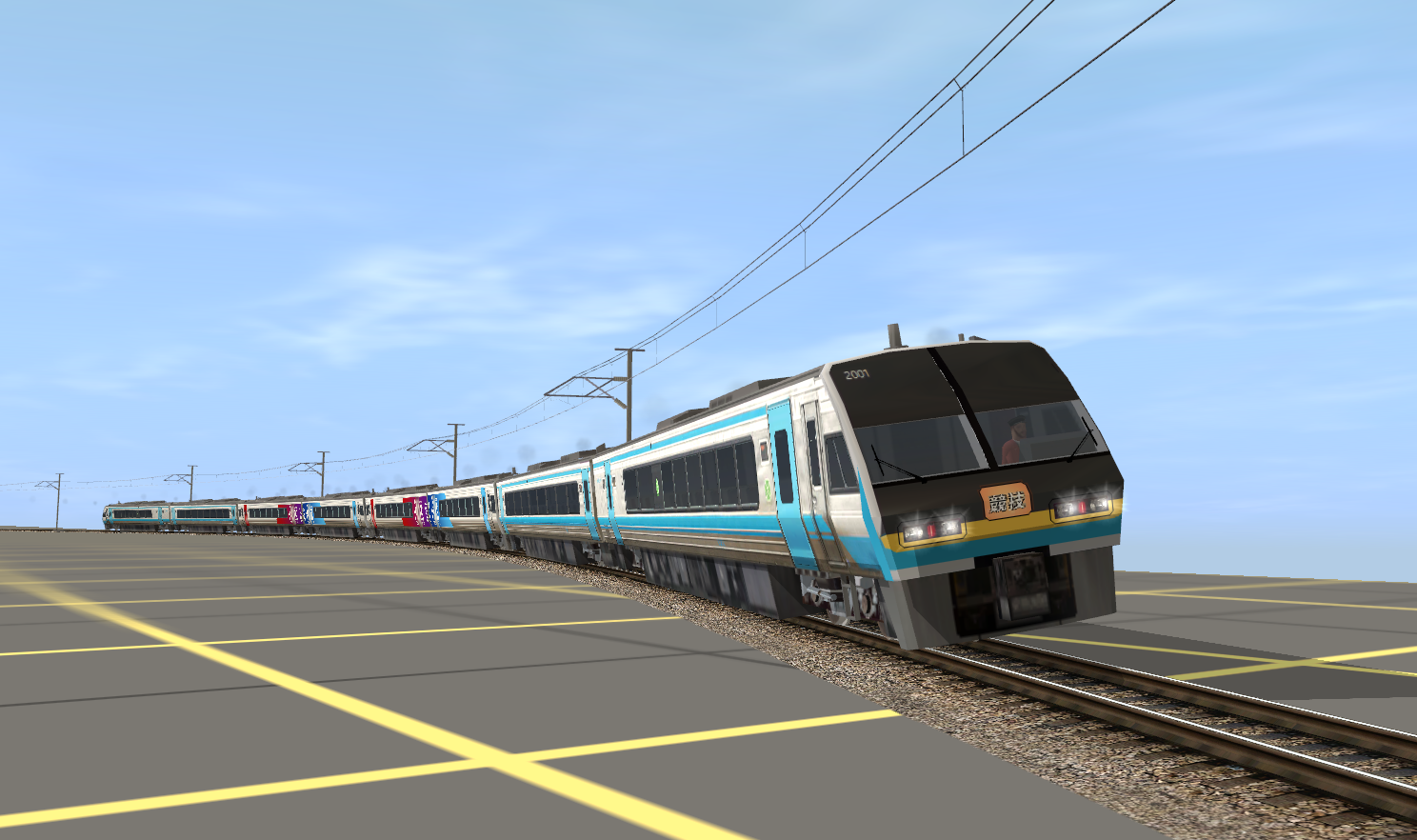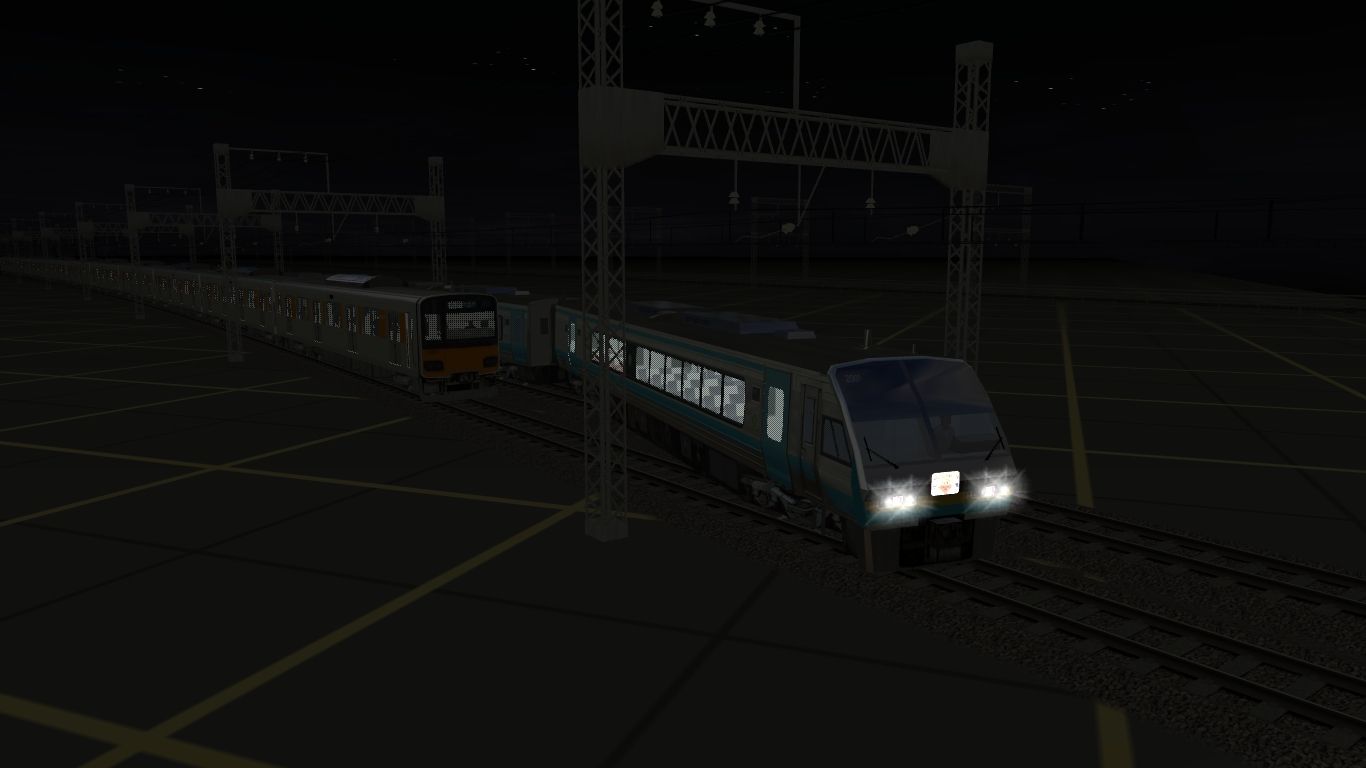Is there any plans about a Regauged version of Kenichiro's DD51? Since, his model is set at standard gauge not 1067mm (42in) gauge. The prototypical DD51 is 1067mm gauge.
Currently no, altough the only thing needed would be a pair of new bogeys. Anyway, in my honest opinion, i don't think the gauge difference is that noticeable.
---
Anyway, i've finally completed the KiHa 120 pack!

Top row, from left to right: KiHa 120-0s in the Hiroshima, Shin-Yamaguchi and Kizuki depot liveries, KiHa 120-200s in the Fukui and Kizuki depot liveries and in the all-over vermillion red livery, KiHa 120-300s in the Kameyama, Okayama (some of those units are also in service with Toyama depot), Toyama (both former Shin-Yamaguchi and proper Toyama untits) and Hamada depot liveries. Bottom row, from left to right again: Matsuura Railway MR-100, MR-200 and MR-300 Serieses, Takachiho Railway TR-100 Series, Kumagawa Railway KT-100 Series, Asa Kaigan ASA-300 Series in the Asa East Line and Takachiho Railway livieries, Nishikigawa Railway NT-2000 Series and the Minami-Aso Railway MT-2000 and MT-2000A Serieses.
(phew!)
In total there are 43 individual railcars included in this pack: 33 KiHa 120s of JR West (11 liveries times 3 variants: "original state", "retrofitted toilet" and "refurbished units") plus 10 different diesel railcars of similar design in service for six different third-sector railways.
You can download the "total" pack here (.rar format - uncompressed folder is 291MB) - individual packs will be avaible soon on my website. This time, all the necessary dependencies are included in the package, so there shouldn't be any problem.
So, the KiHa 120 was built by Niigata Transys between 1992 and 1996, and was designed as a lightweight and cheap to maintain and run replacement for a conspicuous part of DMUs used by the newly-formed JR West on local services thruought much of it's unelectrified lines.
Specifically, the new diesel railcars were to replace the ageing KiHa 20s, the severely deteriorated KiHa 35s and KiHa 45s and the KiHa 58s - some units, wich due to a shortage of DMUs, had been assigned to local services, but as KiHa 58s are geared for higher-speed rapid and express services, suffered from premature wear.
Unlike all the other JR-Group companies, wich remained loyal to the JNR design dictates, JR West opted instead for a shorter, lighter, cheaper and predisposed-for-one-man-operation design. This had several advantage, in regard of saving money, one of JR West's main concerns: a shorter and lighter design meant less wear on the tracks and the train itself and less fuel consumption, wich meant less maintainance and running expenses (nonetheless, a shorter bodyshell is also cheaper to manufacture while not being too much of an impedment on a line with low ridership), and the implementation of one-man operation meant that, by eliminating conductors, crew expenses (wich aren't quite trascurable) could be effectively cut in half.
With the rough concept set, JR West looked for a suitable manufacturer. The choiche was possible between two manufacturers only: Fuji Heavy Industries (renamed in 2016 as the "Subaru Corporation" - it is in fact the owner of the Subaru car brand) with it's LE-Car ("Light, Economy") design, wich went from two-axle railbusses to "proper" diesel railcars, and Niigata Transys, with it's NDC ("Niigata Diesel Car"), wich was a middle-way.
Both companies had a vast experience in manufacturing DMUs, but not in designing them! - until then, they only had to follow JNR's blueprints! In fact, JNR had been the only railway company in Japan to order DMUs for almost 40 years, and with all the designing done by JNR technicians and engineers, the two manufacturers had little left to decide.
JR West's new DMU was a chanche for both to introduce their own designs to the national tracks, with both the LE-Car and the NDC proving extremely popular with many of the newly-formed third-sector railways wich had inherited operational (or even uncomplete) lines from JNR.
Niigata's NDC design emerged as the winner in 1991; this was partly due also to the Shigaraki crash, where a light (almost fragile) Fuji Heavy Industries LE-Car of Shigaraki Kogen Railway was obliterated by a head-on crash with an heavy and robust KiHa 58 of JR West.
Designated KiHa 120s, the new DMUs were based on the Matsuura Railway MR-100 Series, wich had been built by Niigata Transys in 1988. JR West's new DMUs were to be divided into three subseries: the -0 subseries, with stainless steel bodies and all-longitudinal seating, the -200 subseries with conventional alluminum bodies and semi-cross seating and the -300 subseries with stainless steel bodies and semi-cross seating.
With a reasonable maximium speed of 95Km/h, the KiHa 120s were equipped with the well-proven 6-cylinder, 11.040cc (330 CV) Komatsu SA6D125 engine and had an automatic gear changer (contrary to most third-sector railways, wich still often used manual gear changing).
The first units to be delivered where the ones of the -200 subseries, wich entered service between March and July 1992. Divided between the depots of Fukui (for services on the Etsumi-Hoku Line) and Kizuki (for services on the namesake Kizuki line), they were painted in two distinctive liveries, one for each depot: white with green motifs and cream, yellow and dark green respectively.
One year later, the first stainless-steel bodied -0 subseries units entered service, assigned to Kizuki depot (with a livery with the same of the -200 subseries units assigned to the same depot), Hiroshima depot (blue and purple livery) for services on the Geibi Line and the non-electrifed portion of the Fukuen Line and Shin-Yamaguchi depot (purple, blue and dark grey livery), for services on the San'in Main Line and the Mine Line.
Finally, in March 1994 the first -300 subseries units were delivered; these were the bulk of the order, and were assigned to Kameyama depot (dark purple livery), for services on the Kansai Main Line, Hamada depot (blue and light-blue livery), for services on the San'in Main Line and the Sanko Line, Okayama depot (orange and red livery), for services on the Tsuyama Line, the Inbi Line, the Kishin Line, the Geibi Line, the Hakubi Line and yet again on the San'in Main Line, and finally, Toyama depot (acqua green, blue, yellow and red livery) for services on the Takayama Main Line, the Oito Line and the short Toyamako Line.
Deliveries terminated in August 1996, with the final seven units being assigned again to Okayama depot. In just four years, Niigata Transys (with the help of JR West's Goto Works) manufcatured a total of 89 KiHa 120s.
With the introduction of the KiHa 120s, JR West retired all of it's remaining KiHa 20s in 1993 and the KiHa 35s and 45s were retired or displaced and relegated to small, unimportant shuttle duties (such as the Omine branch line and the Wadamisaki Line) by a couple of years later. Finally, in the mid-1990s, JR West re-reassigned all the KiHa 58s used until then on local services, back to rapid services, for wich they were far better suited and designed.
After their introduction, the KiHa 120s lived a tranquil, uneventful life for almost 30 years, with the few notable events being the closing of the Toyamako Line in 2006 (wich was converted into a modern tramway line later that year: today's Toyama Chiho Railway Toyamako "PortTram" Line) and in 2007, the retrofittment of toilets on all the 89 units of the fleet. Finally, in 2011, the livery of all the -200 subseries units was changed into an all-over vermillion red livery, reminescent (actually, identical) of the JNR-era "Metropolitan Red" livery for DMUs.
Around this period, some Shin-Yamaguchi and Okayama depot units were transferred to Toyama depot to supplement "native" KiHa 120s on Oito Line duties. Of the two, the units coming from Shin-Yamaguchi recieved a new livery, similar to the Toyama depot units, while the ex-Okayama units kept (and still keep) their orange and red livery.
Starting from 2017, 25 years after the introduction of the first units, JR West decided to refurbish it's fleet of KiHa 120s, wich had been proven as reliable and cheap to maintain and run DMUs, and by then, had become an unvaluable asset in JR West's fleet.
The refurbishment program included the repairation of the bodyshells, new LED front lights, new seat upholstery, reinforcment of front windows and a chime for the doors. KiHa 120-208 (an all-over vermillion red liveried unit) was the first to be refurbished, re-entering service on the 16th of July 2017.
At a cost of 25 million yen per car, all 89 KiHa 120 units will undergo the refurbishment program, wich is to be completed by 2021. In 2018, the Sanko Line closed, with the fleet of KiHa 120s serving the line being reassigned and transferred to the San'in Main Line.
Lastly, in March 2020, KiHa 120-358 (the second-to-last KiHa 120 unit to be delivered), assigned to Okayama depot, hit a landslide on the Geibi Line and derailed. Nobody was injured, but the railcar suffered serious damages, and was subsequently scrapped - the only KiHa 120 unit to be scrapped (or to ever have been involved in an accident).
Trivia:
Taking into mind the Shigaraki crash, and the fact that they aren't equipped with ATS-P (but only with the very basic ATS-S), KiHa 120s are effectively banned (with very few exceptions) from running on "Mainline" tracks shared with more robust trains, and are strictly forbidden by JR West to run in the company's "urban network" (the ensemble of commuter, suburban and regional lines radiating from Osaka).
Next: predecessors and derivatives for the third sector railways.
Last edited:





